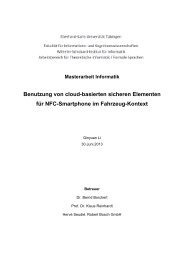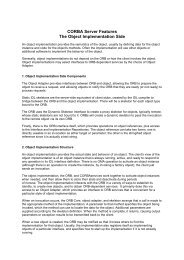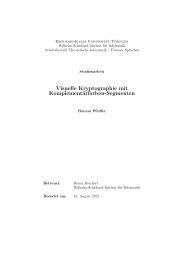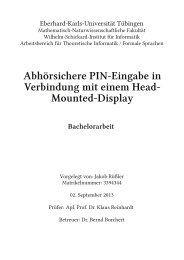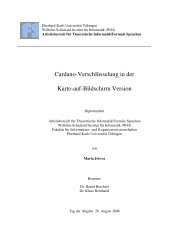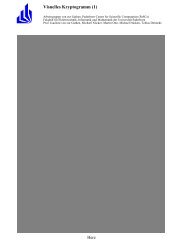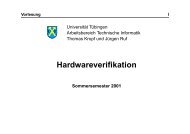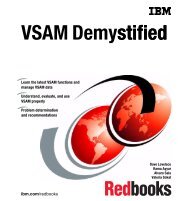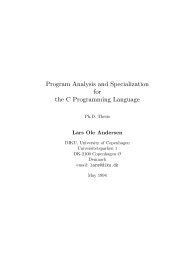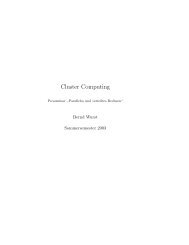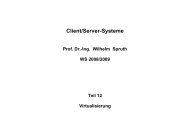Tutorial 7
Tutorial 7
Tutorial 7
Create successful ePaper yourself
Turn your PDF publications into a flip-book with our unique Google optimized e-Paper software.
tutor07.doc<br />
<strong>Tutorial</strong> 7<br />
MQSeries<br />
Copyright © Abt. Computersysteme, Institut für Informatik, Universität Leipzig<br />
In this exercise, we design a message queue, send a messages and read it back again.<br />
Note: This tutorial was generated with the user-ID "PRAKT20". In all file names, you must replace<br />
"PRAKT20" by your own user-ID. Moreover, PRAKTxx is used often in the text below, whereby the xx<br />
should be your user ID.<br />
Exercise: Work through the following tutorial<br />
MQSeries<br />
For commercial Messaging and Queuing, MQSeries represents a platform independent<br />
Middleware-product. It is used especially in high speed - implementations of distributed<br />
applications. MQSeries is popular, because it is possible to develop and test MQSeries<br />
applications with a minimum amount of time and resources.<br />
Since MQSeries is capable of running on many different platforms, programs can as a result<br />
work together over a network of different components, processors, subsystems, operating<br />
systems and communication protocols. MQSeries-programs use a consistent application<br />
interface (API) on all platforms. Figure 1 shows the main components of a MQSeries<br />
application.<br />
Figure a: MQSeries in Action<br />
1
tutor07.doc<br />
MQSeries enables the communication between different user-programs. Program A<br />
generates a message as available and writes its into a Queue. Program B reads this<br />
Message from the Queue and processes it.<br />
Both programs A and B use a special MQSeries Application program interface (API) in order<br />
to write messages into the Queue and/or to read out of the Queue. The MQ Series-API is<br />
named Message Queue interface (MQI).<br />
It is possible that program B is not running when program A places a message into the<br />
Queue. In this case, the Queue stores the message until program B is started and can<br />
retrieve it. On the other hand, program A can be inactive when program B retrieves the<br />
message out of the Queue. For MQSeries, it is not necessary that both communicating<br />
programs must be simultaneously active. MQSeries makes asynchronous processing<br />
possible.<br />
Before we start, some MQSeries objects and/or definitions must be explained.<br />
Message<br />
A message consists of two parts:<br />
- Data that are sent by one program to another.<br />
- A message descriptor or message header<br />
The message descriptor identifies the messages (with a message ID) and contains guiding<br />
information (attributes), as well as a message-type, time-flow, correlation-ID, priority and<br />
name of the answer queue.<br />
The message length is dependent on the version of MQ Series being used. MQSeries<br />
version 5 (for distributed platform) supports a maximal message-length of 100 MByte. On our<br />
OS/390 system at the University of Leipzig, MQSeries version 2.1 has been installed and<br />
supports messages up to 4 MByte.<br />
Queue Manager<br />
A Queue manager (QMGR) is the MQSeries software, that is assigned to a queue. It<br />
administers the objects belonging to MQSeries, especially Queues, Channels, process<br />
definitions, and others.<br />
In addition, the Queue manager makes the Message Queue Interface (MQI) available. An<br />
application the MQI to access queues and messages contained therein. The MQI<br />
implements a simple application program interface that is identical for all supported<br />
platforms. Through the MQI, the applications are separated from the Queue manager.<br />
An application must establish a communication with the Queue manager before it can access<br />
its resources. For this it uses the commands MQCONN or MQCONNX. If the application no<br />
longer requires a connection to the Queue manager, MQDISC is used to disconnect,<br />
In order to access a Queue, an application must first open this Queue. This is done by<br />
means of the MQOPEN call. With MQCLOSE, the Queue is closed again.<br />
With a queue opened, the application uses the command MQPUT in order to write a<br />
message into a Queue. With the call MQGET, a message can be read out of the Queue. By<br />
2
tutor07.doc<br />
means of the call MQPUT1, an application can, in one step, open a queue, write messages<br />
into the Queue and close the Queue again.<br />
Queue, Queue manager and processes are examples of MQSeries objects.<br />
When installating MQSeries on a server, the Queue manager must be setup by a systems<br />
programmer.<br />
The name of the Queue manager in our OS/390 MQSeries-installation is MQA1.<br />
Queue<br />
When an application writes a message into a Queue, the Queue manager will assure that the<br />
message is savely stored, recoverable and is delivered only once at the receiving end. This<br />
also applies if a message must be sent to a Queue of another Queue manager. This<br />
mechanism within the framework of MQSeries is called "secured delivery".<br />
There are persistent and non-persistent messages. Persistent messages are written in the<br />
MQSeries log and are available again after a new start of the QMGRs. Non-persistent<br />
messages are no longer available after a new start of the QMGRs.<br />
When an application opens a Queue, the Queue manager determines whether we are<br />
dealing with a "local Queue" or a "remote Queue". A local Queue is a queue that belongs to<br />
the Queue manager which interacts with the application. A Queue is named as "remote" if it<br />
belongs to another Queue manager.<br />
When an application issues the command MQPUT, the Queue manager writes the message<br />
to the local Queue. If it concerns a "remote" Queue, the Queue manager retrieves from its<br />
definition the information that is necessary for correct delivery (name of the remote QMGR,<br />
name of the remote Queue, name of the associated transmission Queue). The message is<br />
placed is into an inbetween-Queue (transmission Queue), and is assigned to the remote<br />
QMGR.<br />
Subsequently it is the task of the message Channel agent (MCA) to read the message of the<br />
transmission Queue and to send it over the network to a receiving MCA. The latter writes the<br />
message into the taget-Queue. After this the message in the transmission Queue is deleted.<br />
In our exercise, a local Queue must be set up first<br />
3
User Programs<br />
tutor07.doc<br />
Data exchange between two user-programs takes place via the MQI. The latter represents a<br />
call interface with a limited number of calls and extensive options for each call. Preset<br />
standard and start values guarantee a quick start.<br />
The MQI uses a set of structures and constants. With MQSeries, files and copybooks are<br />
included, that contain the definitions of these structures and their fields as well as the<br />
definitions of symbolic names, that are used for constants within the program logic.<br />
A program talks directly with its Queue manager. It resides on the same processor (or<br />
domain for clients) as the program itself.<br />
When the connection between a client and its server is interrupted, no API-Calls can be<br />
carried out because all objects are on the server.<br />
There exist a total of 13 APIs. They are listed in figure 20. The most important APIs<br />
are:MQCONN, MQOPEN, MQPUT, MQGET, MQCLOSE and MQDISC.<br />
Figure b: MQSeries APIs<br />
4
These are the individual APIs:<br />
tutor07.doc<br />
MQCONN establishes a connection with a Queue-manager with the help of standard links.<br />
MQCONNX: A connection with a Queue-manager over a fast path. Fastpath-PUTs and -<br />
GETs are faster; the application must however be well tested. The application and the<br />
Queue-manager run in the same process. If the application collapses, then the Queuemanager<br />
follows. This API-Call is new in MQSeries version 5.<br />
Version 5.<br />
MQBEGIN: starts a unit of work that is coordinated by the Queue-manager. It may contain<br />
external XA-Compatible-resource-managers. This API was introduced with MQSeries version<br />
5. It is used for the coordination of transactions, that use Queues (MQPUT and MQGET<br />
under syncpoint-conditions) and database-updates (SQL commands).<br />
MQPUT1: opens a Queue, transfers a message and closes the Queue again. This API-Call<br />
represents a combination of MQOPEN, MQPUT and MQCLOSE.<br />
MQINQ: Requests information over the Queue-manager or over one of its objects, like the<br />
number of messages in a Queue.<br />
MQSET: Changes some attributes of an object.<br />
MQCMIT: Indicates that a Syncpoint was reached. The messages are generated as part of a<br />
Unit of Work and are made available for other applications. Returned messages are deleted.<br />
MQBACK: Informs the Queue Manager about all returned PUT´s and GET´s messages<br />
since the last Syncpoint. Messages that were generates as part of a Unit of work are deleted.<br />
Returned messages are put on the Queue again.<br />
MQDISC: includes the transfer of a working unit: The termination of a program without<br />
interruption of the connection to the Queue-manager causes a "rollback" (MQBACK).<br />
In order to carry out this exercise, it is necessary that the Queue manager has been<br />
started. If this is not the case, an authorised user must start the Queue manager in<br />
SDSF SYSLOG. The command looks like this:<br />
Command Input === > / ! MQA1 START QMGR<br />
5
tutor07.doc<br />
For our exercise, the following tasks have to be performed:<br />
- Design local queue<br />
- Search for Module A (PUT) and B (GET)<br />
- Design Libraries PRAKTxx.MQA1.USERJCL, which contain the Members MQPUT and<br />
MQGET.<br />
- Rework members MQPUT and MQGET.<br />
- Execute MQGET and MQPUT.<br />
- Review result<br />
For the communication of the two user-programs a "local Queue" is required. In order to<br />
generate the latter, we select the "MQSeries for OS/390-Main Menu" of the Custompac<br />
master application Menu (CMAM). For this we select "m" as an option and press the Enterkey.<br />
CUSTOMPAC MASTER APPLICATION MENU<br />
OPTION ===> m SCROLL ===> PAGE<br />
IS ISMF - Interactive Storage Management Facility<br />
P PDF - ISPF/Program Development Facility<br />
ATC ATC - Application Testing Collection<br />
ART ARTT - Automated Regression Testing Tool<br />
DB2 DB2 - Perform DATABASE 2 interactive functions<br />
QMF QMF - QMF Query Management Facility<br />
C CPSM - CICSPlex/SM<br />
M MQ - MQSeries<br />
IP IPCS - Interactive Problem Control Facility<br />
OS SUPPORT - OS/390 ISPF System Support Options<br />
OU USER - OS/390 ISPF User Options<br />
SM SMP/E - SMP/E Dialogs<br />
SD SDSF - System Display and Search Facility<br />
R RACF - Resource Access Control Facility<br />
DI DITTO - Data Interfile Transfer, Testing and Operations<br />
HC HCD - Hardware Configuration Definition<br />
S SORT - DF/SORT Dialogs<br />
BMR BMR READ - BookManager Read (Read Online Documentation)<br />
F1=HELP F2=SPLIT F3=END F4=RETURN F5=RFIND F6=RCHANGE<br />
F7=UP F8=DOWN F9=SWAP F10=LEFT F11=RIGHT F12=RETRIEVE<br />
Figure 1: Screen of CMAM with selected option "m"<br />
As a result of our action, the Main Menu of MQSeries appears.<br />
6
IBM MQSeries for OS/390 - Main Menu<br />
Complete fields. Then press Enter.<br />
tutor07.doc<br />
Action . . . . . . . . 2 1. Display 5. Perform<br />
2. Define 6. Start<br />
3. Alter 7. Stop<br />
4. Delete<br />
Object type . . . . . QLOCAL +<br />
Name . . . . . . . . . PRAKT20<br />
Like . . . . . . . . . ________________________________________________<br />
Connect to queue<br />
manager . . . . . . :<br />
Target queue manager :<br />
Response wait time . : 30 seconds<br />
(C) Copyright IBM Corporation 1993,1999. All rights reserved.<br />
Command ===> __________________________________________________________________<br />
F1=Help F2=Split F3=Exit F4=Prompt F6=QueueMgr F9=Swap<br />
F10=Messages F12=Cancel<br />
Figure 2: MQSeries for OS/390 - Main Menu<br />
In the Main Menu, we enter in the line "Action" a 2 (Define). As an "Object type" and "name"<br />
we enter QLOCAL and/or PRAKTxx. All remaining entries remain as they are. A local Queue<br />
is defined with the name "PRAKTxx". The latter belongs to the Queue manager MQA1.<br />
Hint: If the error message "CSQO040I Object named PRAKT20 of type QUEUE already<br />
exists" appears, then a local Queue already exists with the name PRAKTxx. Please delete<br />
the old queue. Input a 4in the Panel "IBM MQSeries for OS/390 - Main Menu" in the line<br />
"Action". For "Object type" and "name" enter QLOCAL and PRAKTxx. Assure that both lines<br />
marked Queue Manager contain the entry "MQA1".<br />
Hitting the entry key three times deletes the Queue. The message: "CSQ9022I! MQA1<br />
CSQMUQLC ' DELETE QLOCAL' NORMALLY COMPLETION" confirms successful deletion.<br />
Use the F6 key in order to activate/access Menu changes in the fields "Connect to QMGR"<br />
and "Target QMGR" in the Menu.<br />
We enter 2 times “MQA1“ as a Queue manager. (See fig. 3)<br />
7
IBM MQSeries for OS/390 - Main Menu<br />
tutor07.doc<br />
Complete fields. Then press Enter.<br />
.-----------------------------------------------------------------------------.<br />
| Change the Queue Manager |<br />
| |<br />
| Make changes and press Enter. |<br />
| |<br />
| Connect to queue |<br />
| manager . . . . . . . MQA1 |<br />
| |<br />
| Target queue manager . MQA1 |<br />
| |<br />
| Response wait time . . 30 5 - 999 seconds |<br />
| |<br />
| |<br />
| F1=Help F2=Split F9=Swap F12=Cancel |<br />
'-----------------------------------------------------------------------------'<br />
(C) Copyright IBM Corporation 1993,1999. All rights reserved.<br />
Command ===> SYSID<br />
F1=Help F2=Split F3=Exit F4=Prompt F6=QueueMgr F9=Swap<br />
F10=Messages F12=Cancel<br />
Figure 3: “Change the Queue Manager”<br />
By hitting the Enter key these values are received. We should see a screen similar to Fig. 4<br />
IBM MQSeries for OS/390 - Main Menu<br />
Complete fields. Then press Enter.<br />
Action . . . . . . . . 2 1. Display 5. Perform<br />
2. Define 6. Start<br />
3. Alter 7. Stop<br />
4. Delete<br />
Object type . . . . . QLOCAL +<br />
Name . . . . . . . . . PRAKT20<br />
Like . . . . . . . . . ________________________________________________<br />
Connect to queue<br />
manager . . . . . . : MQA1<br />
Target queue manager : MQA1<br />
Response wait time . : 30 seconds<br />
(C) Copyright IBM Corporation 1993,1999. All rights reserved.<br />
Command ===> __________________________________________________________________<br />
F1=Help F2=Split F3=Exit F4=Prompt F6=QueueMgr F9=Swap<br />
F10=Messages F12=Cancel<br />
Figure 4: MQSeries Main Menu<br />
Subsequently hit the Enter-key. A further Screen appears as a result for the definition of the<br />
local Queue.<br />
8
Define a Local Queue<br />
tutor07.doc<br />
Complete fields, then press F8 for further fields, or Enter to define queue.<br />
More: +<br />
Queue name . . . . . . . . . PRAKT20<br />
Description . . . . . . . . . ________________________________<br />
________________________________<br />
Put enabled . . . . . . . . . Y Y=Yes,N=No<br />
Get enabled . . . . . . . . . Y Y=Yes,N=No<br />
Usage . . . . . . . . . . . . N N=Normal,X=XmitQ<br />
Storage class . . . . . . . . DEFAULT<br />
Command ===> __________________________________________________________________<br />
F1=Help F2=Split F3=Exit F7=Bkwd F8=Fwd F9=Swap<br />
F10=Messages F12=Cancel<br />
Figure 5: 2. Define Screen<br />
In this Screen, the name of the Queue must be registered (PRAKTxx) once more. To enable<br />
Put and Get, we select Y (Yes) for both. All other parameters are entered as shown in figure<br />
5.<br />
Subsequently we hit Key F8. The result is a 3 Define Screen (Fig.6) in which in the line<br />
"Default persistence" = "N" (No) is entered. A message is called "persistent" if it is still<br />
available after a restart of the Queue manager. It doesn’t matter whether the Queue manager<br />
was stopped by an operator command or stopped by a system error. This means that<br />
persistent messages are written into a protocol. If after an error a Queue manager is started<br />
again, it reproduces the messages from the protocol data.<br />
9
Define a Local Queue<br />
tutor07.doc<br />
Press F7 or F8 to see other fields, or Enter to define queue.<br />
More: - +<br />
Default persistence . . . . . N Y=Yes,N=No<br />
Default priority . . . . . . 0 0 - 9<br />
Message delivery sequence . . P P=Priority,F=FIFO<br />
Permit shared access . . . . N Y=Yes,N=No<br />
Default share option . . . . E E=Exclusive,S=Shared<br />
Index type . . . . . . . . . N N=None,M=MsgId,C=CorrelId,T=MsgToken<br />
Maximum queue depth . . . . . 999999999 0 - 999999999<br />
Maximum message length . . . 4194304 0 - 4194304<br />
Retention interval . . . . . 999999999 0 - 999999999 hours<br />
Cluster name . . . . . . . . ________________________________________________<br />
Cluster namelist name . . . . ________________________________________________<br />
Default bind . . . . . . . . O O=Open,N=Notfixed<br />
Command ===> __________________________________________________________________<br />
F1=Help F2=Split F3=Exit F7=Bkwd F8=Fwd F9=Swap<br />
F10=Messages F12=Cancel<br />
Figure 6: Input-Parameter im 2. Define Screen<br />
A message is considered "not-persistent" if it is no longer available after a restart of the<br />
Queue manager. We decide on a not-persistent message for our local Queue "PRAKTxx".<br />
The remaining parameters for the 3 Define Screen are entered as shown in Fig. 6<br />
Define a Local Queue<br />
Press F7 or F8 to see other fields, or Enter to define queue.<br />
Trigger Definition<br />
More: - +<br />
Trigger type . . . . . . . . F F=First,E=Every,D=Depth,N=None<br />
Trigger set . . . . . . . N Y=Yes,N=No<br />
Trigger message priority . 0 0 - 9<br />
Trigger depth . . . . . . 1 1 - 999999999<br />
Trigger data . . . . . . . ________________________________<br />
________________________________<br />
Process name . . . . . . . ________________________________________________<br />
Initiation queue . . . . . ________________________________________________<br />
Command ===> __________________________________________________________________<br />
F1=Help F2=Split F3=Exit F7=Bkwd F8=Fwd F9=Swap<br />
F10=Messages F12=Cancel<br />
Figure 7: 3. Define Screen<br />
Via F8 another three define screens can be called. We do not take advantage of this and hit<br />
in the 3 define screen.<br />
10
tutor07.doc<br />
As a result of this action, the Screen "display messages" appears. It shows whether the<br />
encountered definitions were successful for our local Queue "PRAKTxx" (fig. 7)<br />
Define a Local Queue<br />
Complete fields, then press F8 for further fields, or Enter to define queue.<br />
More: +<br />
Queue name . . . . . . . . . PRAKT20<br />
Description . . . . . . . . . ________________________________<br />
________________________________<br />
Put enabled . . . . . . . . . Y Y=Yes,N=No<br />
Get enabled . . . . . . . . . Y Y=Yes,N=No<br />
Usage . . . . . . . . . . . . N N=Normal,X=XmitQ<br />
Storage class . . . . . . . . DEFAULT<br />
CSQ9022I !MQA1 CSQMMSGP ' DEFINE QLOCAL' NORMAL COMPLETION<br />
Command ===> __________________________________________________________________<br />
F1=Help F2=Split F3=Exit F7=Bkwd F8=Fwd F9=Swap<br />
F10=Messages F12=Cancel<br />
Figure 8: Display messages<br />
As a result of this action, the Screen appears "display messages" that issues, whether the<br />
encountered definitions were successful for our local Queue "PRAKTxx" (fig. 8)<br />
IBM MQSeries for OS/390 - Main Menu<br />
Complete fields. Then press Enter.<br />
Action . . . . . . . . 1 1. Display 5. Perform<br />
2. Define 6. Start<br />
3. Alter 7. Stop<br />
4. Delete<br />
Object type . . . . . QLOCAL +<br />
Name . . . . . . . . . P*<br />
Like . . . . . . . . . ________________________________________________<br />
Connect to queue<br />
manager . . . . . . : MQA1<br />
Target queue manager : MQA1<br />
Response wait time . : 30 seconds<br />
(C) Copyright IBM Corporation 1993,1999. All rights reserved.<br />
Command ===> __________________________________________________________________<br />
F1=Help F2=Split F3=Exit F4=Prompt F6=QueueMgr F9=Swap<br />
F10=Messages F12=Cancel<br />
Figure 9: MQSeries Main Menu<br />
11
tutor07.doc<br />
This screen lists all local Queues with its definitions that begin with "P". With the key F11,<br />
important parameters of the local Queues can be displayed on the screens. The result is<br />
shown in figure 10.<br />
List Local Queues Row 1 of 1<br />
Type action codes. Then press Enter.<br />
1=Display 2=Define like 3=Alter 4=Delete<br />
Name Depth Get In Put Out<br />
_ PRAKT20 0 Y 0 Y 0<br />
******** End of list ********<br />
Command ===> __________________________________________________________________<br />
F1=Help F2=Split F3=Exit F5=Refresh F6=Clusinfo F7=Bkwd<br />
F8=Fwd F9=Swap F10=Messages F11=Attrs F12=Cancel<br />
Figure 10: List Local Queues<br />
Exercise: Set up a Local Queue with the name PRAKTxx (xx from your user ID) and check<br />
whether your Queue was implemented correctly or not.<br />
As the next step we generate the source code for the user-programs A and B in the<br />
programming language COBOL II. Because we do not presume, that the participant has any<br />
COBOL knowledge, we can simply copy the required source code for the programs A (PUT)<br />
and B (GET) from the IBM MQSeries library. It will be under the directory MQM.SCSQCOBS.<br />
The libraries already exist on the server in compiled form. In order to get an overview of both<br />
of the COBOL program modules, we do the following: In the Custompac master application<br />
Menu, we enter option P.3.4 and hit the enter key. As a result we obtain the Data List Utility<br />
(figure 11)<br />
12
tutor07.doc<br />
Menu RefList RefMode Utilities Help<br />
------------------------------------------------------------------------------<br />
Data Set List Utility<br />
blank Display data set list P Print data set list<br />
V Display VTOC information PV Print VTOC information<br />
Enter one or both of the parameters below:<br />
Dsname Level . . . MQM.SCSQCOBS<br />
Volume serial . .<br />
Data set list options<br />
Initial View . . . 2 1. Volume Enter "/" to select option<br />
2. Space / Confirm Data Set Delete<br />
3. Attrib / Confirm Member Delete<br />
4. Total<br />
When the data set list is displayed, enter either:<br />
"/" on the data set list command field for the command prompt pop-up,<br />
an ISPF line command, the name of a TSO command, CLIST, or REXX exec, or<br />
"=" to execute the previous command.<br />
Option ===><br />
F1=Help F3=Exit F10=Actions F12=Cancel<br />
Figure 11: Data Set List Utility<br />
In this Screen on the line "Dsname level" enter the PDS-name "MQM. SCSQCOBS". This<br />
library, together with MQM.SCSQCOBC forms an integral component of MQSeries . The first<br />
library contains among others the COBOL II-source program module for PUT and GET<br />
(.S -> source, while the second contains the copy book (...C ->Copy).<br />
In the line, “Initial View”, a "2" is entered (Space). Subsequently we hit the Enter-key. The<br />
following Screen “DSLIST- Data Sets Matching MQM.SCSQCOBS” displays the used<br />
storage space on a 3390-Device. (figure 12)<br />
13
tutor07.doc<br />
Menu Options View Utilities Compilers Help<br />
------------------------------------------------------------------------------<br />
DSLIST - Data Sets Matching MQM.SCSQCOBS Row 1 of 1<br />
Command - Enter "/" to select action Tracks %Used XT Device<br />
------------------------------------------------------------------------------b<br />
MQM.SCSQCOBS 44 84 1 3390<br />
***************************** End of Data Set list ****************************<br />
Command ===> Scroll ===> PAGE<br />
F1=Help F3=Exit F5=Rfind F12=Cancel<br />
Figure 12: DSLIST<br />
We enter a "b" (for browse) before the file names MQM. SCSQCOBS and hit the Enter- key.<br />
The result screen lists all members of this PDS as shown in Fig.11<br />
Menu Functions Confirm Utilities Help<br />
------------------------------------------------------------------------------<br />
BROWSE MQM.SCSQCOBS Row 00001 of 00023<br />
Name Prompt VV MM Changed Size Init Mod ID<br />
_________ CSQ4BVA1<br />
_________ CSQ4BVJ1<br />
s________ CSQ4BVK1<br />
_________ CSQ4CVB1<br />
_________ CSQ4CVB2<br />
_________ CSQ4CVB3<br />
_________ CSQ4CVB4<br />
_________ CSQ4CVB5<br />
_________ CSQ4CVC1<br />
_________ CSQ4CVD1<br />
_________ CSQ4CVD2<br />
_________ CSQ4CVD3<br />
_________ CSQ4CVD4<br />
_________ CSQ4CVD5<br />
_________ CSQ4CVJ1<br />
_________ CSQ4CVK1<br />
_________ CSQ4TVD1<br />
_________ CSQ4TVD2<br />
Command ===> Scroll ===> PAGE<br />
F1=Help F3=Exit F10=Actions F12=Cancel<br />
Figure 13: Member des PDS MQM.SCSQCOBS<br />
When you enter the command "S" (Select) on the line in front of the Member CSQ4BVK1, the<br />
source code of this module can be displayed (figure 12).<br />
With the keys F8 and F7 we can scroll forwards or backwards.<br />
14
tutor07.doc<br />
Menu Utilities Compilers Help<br />
-------------------------------------------------------------------------------<br />
BROWSE MQM.SCSQCOBS(CSQ4BVK1) Line 00000000 Col 001 080<br />
********************************* Top of Data **********************************<br />
CBL NODYNAM,LIB,OBJECT,RENT,RES,APOST<br />
* *<br />
* ------------------------------------------------------------- *<br />
IDENTIFICATION DIVISION.<br />
* ------------------------------------------------------------- *<br />
PROGRAM-ID. CSQ4BVK1.<br />
*REMARKS<br />
*****************************************************************<br />
* @START_COPYRIGHT@ *<br />
* Statement: Licensed Materials - Property of IBM *<br />
* *<br />
* 5655-A95 *<br />
* (C) Copyright IBM Corporation. 1993, 1998 *<br />
* *<br />
* Status: Version 2 Release 1 *<br />
* @END_COPYRIGHT@ *<br />
* *<br />
* Module Name : CSQ4BVK1 *<br />
Command ===> Scroll ===> PAGE<br />
F1=Help F3=Exit F5=Rfind F12=Cancel<br />
Figure 14: 1. Screen des Quellcodes von CSQ4BVK1<br />
By entering F3, one goes back into the list of members for MQM. SCSQCOBS. You can<br />
inspect the source code for the members CSQ4BVJ1 by means of the select command on<br />
the screen.<br />
We now need two JCL scripts in order to send a message to the message queue MQA1 and<br />
toreceive a message.<br />
Before we copy these two modules, we need to create a private library with the name<br />
PRAKTxx.MQA1.USERJCL. We do this as shown in <strong>Tutorial</strong> 1. Please enter the values as<br />
showm in figure 15:<br />
15
tutor07.doc<br />
Menu RefList Utilities Help<br />
------------------------------------------------------------------------------<br />
Allocate New Data Set<br />
More: +<br />
Data Set Name . . . : PRAKT20.MQA1.USERJCL<br />
Management class . . . DEFAULT (Blank for default management class)<br />
Storage class . . . . PRIM90 (Blank for default storage class)<br />
Volume serial . . . . SMS003 (Blank for system default volume) **<br />
Device type . . . . . (Generic unit or device address) **<br />
Data class . . . . . . (Blank for default data class)<br />
Space units . . . . . TRACK (BLKS, TRKS, CYLS, KB, MB, BYTES<br />
or RECORDS)<br />
Average record unit (M, K, or U)<br />
Primary quantity . . 3 (In above units)<br />
Secondary quantity 1 (In above units)<br />
Directory blocks . . 5 (Zero for sequential data set) *<br />
Record format . . . . FB<br />
Record length . . . . 80<br />
Block size . . . . . 6160<br />
Data set name type : PDS (LIBRARY, HFS, PDS, or blank) *<br />
(YY/MM/DD, YYYY/MM/DD<br />
Command ===><br />
F1=Help F3=Exit F10=Actions F12=Cancel<br />
Figure 15: Designing a New Data Set<br />
This PDS (partitioned data set) should receive the corresponding JCL-Script2 for the PUT<br />
and GET jobs. We copy from the PDS MQM.SCSQPROC the Member CSQ4BVJR. This<br />
member should be copied twice and named MQPUT and MQGET. We now have a JCL<br />
script with the Members MQPUT and MQGET. MQPUT contains the job, that through calling<br />
the module CSQ4BVK1 with the corresponding parameters (QMGR, QUEUE, MSGS, PAD,<br />
LEN and PERS) writes a message into the local Queue and displays the result on the<br />
screen. MQGET implements the job that reads this message through calling the module<br />
CSQ4BVJ1 with identical parameters (as MQPUT) from the local Queue and displays the<br />
results to the screen.<br />
The copying can be done (option P.3.3) by means of the Move/Copy Utility.<br />
16
tutor07.doc<br />
Menu RefList Utilities Help<br />
------------------------------------------------------------------------------<br />
Move/Copy Utility<br />
More: +<br />
C Copy data set or member(s) CP Copy and print<br />
M Move data set or member(s) MP Move and print<br />
L Copy and LMF lock member(s) LP Copy, LMF lock, and print<br />
P LMF Promote data set or member(s) PP LMF Promote and print<br />
Specify "From" Data Set below, then press Enter key<br />
From ISPF Library:<br />
Project . . . (--- Options C, CP, L, and LP only ----)<br />
Group . . . . . . . . . . . . .<br />
Type . . . .<br />
Member . . . (Blank or pattern for member list,<br />
"*" for all members)<br />
From Other Partitioned or Sequential Data Set:<br />
Data Set Name . . . 'MQM.SCSQPROC(CSQ4BVJR)'<br />
Volume Serial . . . (If not cataloged)<br />
Option ===> C<br />
F1=Help F3=Exit F10=Actions F12=Cancel<br />
Figure 16: Kopieren von CSQ4BVJR<br />
We input the values as indicated above, hit the Enter-key and arrive at the following Screen:<br />
Menu RefList Utilities Help<br />
------------------------------------------------------------------------------<br />
COPY From MQM.SCSQPROC(CSQ4BVJR)<br />
More: +<br />
Specify "To" Data Set Below<br />
To ISPF Library:<br />
Project . . PRAKT20 Replace option:<br />
Group . . . MQA1 Enter "/" to select option<br />
Type . . . . USERJCL Replace like-named members<br />
Member . . . MQGET (Blank unless member is to be renamed)<br />
To Other Partitioned or Sequential Data Set:<br />
Data Set Name . . .<br />
Volume Serial . . . (If not cataloged)<br />
Data Set Password . . (If password protected)<br />
To Data Set Options:<br />
Sequential Disposition Pack Option SCLM Setting<br />
1 1. Mod 3 1. Yes 3 1. SCLM<br />
2. Old 2. No 2. Non-SCLM<br />
Command ===><br />
F1=Help F3=Exit F10=Actions F12=Cancel<br />
Figure 17: Kopieren von CSQ4BVJR nach MQGET<br />
We copy the same Member once again, but now store it under<br />
PRAKTxx.MQA1.USERJCL.MQPUT<br />
17
tutor07.doc<br />
Exercise: Generate the new Dataset and copy the JCL scripts 2 times (as a MQGET and<br />
MQPUT).<br />
Now we edit the members MQPUT and MQGET. Both files are JCL scripts that must be<br />
adapted for our purposes: We open MQPUT by means of the TSO editor:<br />
File Edit Confirm Menu Utilities Compilers Test Help<br />
-------------------------------------------------------------------------------<br />
EDIT PRAKT20.MQA1.USERJCL(MQPUT) - 01.00 Columns 00001 00072<br />
****** ***************************** Top of Data ******************************<br />
==MSG> -Warning- The UNDO command is not available until you change<br />
==MSG> your edit profile using the command RECOVERY ON.<br />
==MSG> -CAUTION- Profile is set to STATS ON. Statistics did not exist for<br />
==MSG> this member, but will be generated if data is saved.<br />
000001 //******************************************************************<br />
000002 //* *<br />
000003 //* @START_COPYRIGHT@ *<br />
000004 //* Statement: Licensed Materials - Property of IBM *<br />
000005 //* *<br />
000006 //* 5655-A95 *<br />
000007 //* (C) Copyright IBM Corporation. 1993, 1998 *<br />
000008 //* *<br />
000009 //* Status: Version 2 Release 1 *<br />
000010 //* @END_COPYRIGHT@ *<br />
000011 //* *<br />
000012 //******************************************************************<br />
000013 //* CUSTOMIZE THIS JCL HERE FOR YOUR INSTALLATION<br />
000014 //* YOU MUST DO GLOBAL CHANGES ON THESE PARAMETERS USING YOUR EDITOR<br />
Command ===> Scroll ===> PAGE<br />
F1=Help F3=Exit F5=Rfind F6=Rchange F12=Cancel<br />
Figure 18: Source text MQPUT<br />
Using the F7 or F8 keys, we can display the source text by scrolling. You can see that the<br />
script has plenty of comments. (The actual script has only 8 lines).<br />
18
If we go to line 56:<br />
tutor07.doc<br />
File Edit Confirm Menu Utilities Compilers Test Help<br />
-------------------------------------------------------------------------------<br />
EDIT PRAKT20.MQA1.USERJCL(MQPUT) - 01.00 Columns 00001 00072<br />
000047 //* - FIRST PARM (++QMGR++) QUEUE MANAGER NAME<br />
000048 //* - SECOND PARM (++QUEUE++) QUEUE NAME<br />
000049 //* - THIRD PARM (++MSGS++) THE NUMBER OF MESSAGES TO GET-(9999)<br />
000050 //* - FOURTH PARM (++GET++) GET TYPE-(B)ROWSE/(D)ESTRUCTIVE<br />
000051 //* - FIFTH PARM (++SYNC++) (S)YNCPOINT/(N)O SYNCPOINT<br />
000052 //* MESSAGES ARE PRINTED TO DD SYSPRINT<br />
000053 //*<br />
000054 //*********************************************************************<br />
000055 //PUTMSGS EXEC PGM=CSQ4BVK1,REGION=1024K,<br />
000056 // PARM=('++QMGR++,++QUEUE++,++MSGS++,++PAD++,++LEN++,++PERS++')<br />
000057 //*GETMSGS EXEC PGM=CSQ4BVJ1,REGION=1024K,<br />
000058 //* PARM=('++QMGR++,++QUEUE++,++MSGS++,++GET++,++SYNC++')<br />
000059 //STEPLIB DD DSN=++USERLIB++,DISP=SHR<br />
000060 // DD DSN=++THLQUAL++.SCSQANL++LANGLETTER++,DISP=SHR<br />
000061 // DD DSN=++THLQUAL++.SCSQAUTH,DISP=SHR<br />
000062 //SYSDBOUT DD SYSOUT=*<br />
000063 //SYSABOUT DD SYSOUT=*<br />
000064 //SYSPRINT DD SYSOUT=*<br />
000065 //SYSOUT DD SYSOUT=*<br />
Command ===> Scroll ===> PAGE<br />
F1=Help F3=Exit F5=Rfind F6=Rchange F12=Cancel<br />
Figure 19: 2. Screen Quelltext MQPUT<br />
The parameters starting at line 56 are very well documented in the script. We replace this<br />
line by:<br />
File Edit Confirm Menu Utilities Compilers Test Help<br />
-------------------------------------------------------------------------------<br />
EDIT PRAKT20.MQA1.USERJCL(MQPUT) - 01.00 Columns 00001 00072<br />
000053 //*<br />
000054 //*********************************************************************<br />
000055 //PUTMSGS EXEC PGM=CSQ4BVK1,REGION=1024K,<br />
000056 // PARM=('MQA1,PRAKT20,3,Z,5,N')<br />
000057 //*PUTMSGS EXEC PGM=CSQ4BVK1,REGION=1024K,<br />
000058 //* PARM=('++QMGR++,++QUEUE++,++MSGS++,++PAD++,++LEN++,++PERS++')<br />
000059 //STEPLIB DD DSN=MQM.MQA1.USERLIB,DISP=SHR<br />
000060 // DD DSN=MQM.SCSQANLE,DISP=SHR<br />
000061 // DD DSN=MQM.SCSQAUTH,DISP=SHR<br />
000062 //SYSDBOUT DD SYSOUT=*<br />
000063 //SYSABOUT DD SYSOUT=*<br />
000064 //SYSPRINT DD SYSOUT=*<br />
****** **************************** Bottom of Data ****************************<br />
Command ===> sub Scroll ===> PAGE<br />
F1=Help F3=Exit F5=Rfind F6=Rchange F12=Cancel<br />
Figure 20: Neuer Quelltext MQPUT<br />
19
tutor07.doc<br />
This means: 3 messages are written into the local Queue whereby each messages consists<br />
of a sequence "ZZZZZ". After editing the parameters, we enter "SUB" on the command line.<br />
The command “SUB” is confirmed by means of “Enter” and the following screen appears:<br />
20
tutor07.doc<br />
File Edit Confirm Menu Utilities Compilers Test Help<br />
-------------------------------------------------------------------------------<br />
EDIT PRAKT20.MQA1.USERJCL(MQPUT) - 01.00 Columns 00001 00072<br />
000053 //*<br />
000054 //*********************************************************************<br />
000055 //PUTMSGS EXEC PGM=CSQ4BVK1,REGION=1024K,<br />
000056 // PARM=('MQA1,PRAKT20,3,Z,5,N')<br />
000057 //*GETMSGS EXEC PGM=CSQ4BVJ1,REGION=1024K,<br />
000058 //* PARM=('++QMGR++,++QUEUE++,++MSGS++,++GET++,++SYNC++')<br />
000059 //STEPLIB DD DSN=++USERLIB++,DISP=SHR<br />
000060 // DD DSN=++THLQUAL++.SCSQANL++LANGLETTER++,DISP=SHR<br />
000061 // DD DSN=++THLQUAL++.SCSQAUTH,DISP=SHR<br />
000062 //SYSDBOUT DD SYSOUT=*<br />
000063 //SYSABOUT DD SYSOUT=*<br />
000064 //SYSPRINT DD SYSOUT=*<br />
000065 //SYSOUT DD SYSOUT=*<br />
****** **************************** Bottom of Data ****************************<br />
P<br />
IKJ56700A ENTER JOBNAME CHARACTER(S) -<br />
Figure 21: „sub MQPUT“<br />
Here we can simply enter P (for Put). Background: the job gets a name that consists of the<br />
login (PRAKTxx) and the entered character (above). (Maximally 8 characters). So our job is<br />
named PRAKTxxP.<br />
We now get the following message:<br />
21
tutor07.doc<br />
File Edit Confirm Menu Utilities Compilers Test Help<br />
-------------------------------------------------------------------------------<br />
EDIT PRAKT20.MQA1.USERJCL(MQPUT) - 01.00 Columns 00001 00072<br />
000055 //PUTMSGS EXEC PGM=CSQ4BVK1,REGION=1024K,<br />
000056 // PARM=('MQA1,PRAKT20,3,Z,5,N')<br />
000057 //*GETMSGS EXEC PGM=CSQ4BVJ1,REGION=1024K,<br />
000058 //* PARM=('++QMGR++,++QUEUE++,++MSGS++,++GET++,++SYNC++')<br />
000059 //STEPLIB DD DSN=++USERLIB++,DISP=SHR<br />
000060 // DD DSN=++THLQUAL++.SCSQANL++LANGLETTER++,DISP=SHR<br />
000061 // DD DSN=++THLQUAL++.SCSQAUTH,DISP=SHR<br />
000062 //SYSDBOUT DD SYSOUT=*<br />
000063 //SYSABOUT DD SYSOUT=*<br />
000064 //SYSPRINT DD SYSOUT=*<br />
000065 //SYSOUT DD SYSOUT=*<br />
****** **************************** Bottom of Data ****************************<br />
IKJ56700A ENTER JOBNAME CHARACTER(S) -<br />
P<br />
IKJ56250I JOB PRAKT20P(JOB00829) SUBMITTED<br />
***<br />
Figure 22: 2. Screen „sub MQPUT“<br />
We press Enter, until a message is displayed on the screen:<br />
11.51.22 JOB00833 $HASP165 PRAKT20P ENDED AT N1 MAXCC=0 CN(INTERNAL)<br />
***<br />
Figure 23: Ausgabe von „sub MQPUT“<br />
This wrote our messages into the local Queue.<br />
22
tutor07.doc<br />
Now these messages must be retrieved. We edit the Member MQGET from the directory<br />
PRAKTxx.MQA1.USERJCL.<br />
It is the same JCL script as for MQGET. We scroll with F8 directly to line 56 and replace the<br />
line with:<br />
23
tutor07.doc<br />
File Edit Confirm Menu Utilities Compilers Test Help<br />
-------------------------------------------------------------------------------<br />
EDIT PRAKT20.MQA1.USERJCL(MQGET) - 01.00 Columns 00001 00072<br />
000053 //*<br />
000054 //*********************************************************************<br />
000055 //*PUTMSGS EXEC PGM=CSQ4BVK1,REGION=1024K,<br />
000056 //* PARM=('++QMGR++,++QUEUE++,++MSGS++,++PAD++,++LEN++,++PERS++')<br />
000057 //GETMSGS EXEC PGM=CSQ4BVJ1,REGION=1024K,<br />
000058 // PARM=('MQA1,PRAKT20,3,D,N')<br />
000059 //STEPLIB DD DSN=MQM.MQA1.USERLIB,DISP=SHR<br />
000060 // DD DSN=MQM.SCSQANLE,DISP=SHR<br />
000061 // DD DSN=MQM.SCSQAUTH,DISP=SHR<br />
000062 //SYSDBOUT DD SYSOUT=*<br />
000063 //SYSABOUT DD SYSOUT=*<br />
000064 //SYSPRINT DD SYSOUT=*<br />
000065 //SYSOUT DD SYSOUT=*<br />
****** **************************** Bottom of Data ****************************<br />
Command ===> sub Scroll ===> PAGE<br />
F1=Help F3=Exit F5=Rfind F6=Rchange F12=Cancel<br />
Figure 24: Neuer Quelltext von MQGET<br />
By entering “sub“ we run the script. The jobname should now be PRAKTxxG, therefore enter<br />
a “G”.<br />
Exercise: Repeat the scripts MQPUT and after that MQGET again.<br />
After a successful run, we may ask ourselves, what has actually happened:<br />
After repeatedly hitting the F3key, we arrive back at the Custompac master application<br />
Menu. Subsequently we enter on the line "option" SD and arrive therewith into the SDSF<br />
panel.<br />
24
tutor07.doc<br />
Display Filter View Print Options Help<br />
-------------------------------------------------------------------------------<br />
HQX1900------------------ SDSF PRIMARY OPTION MENU --------------------------<br />
DA - Display active users in the sysplex<br />
I - Display jobs in the JES2 input queue<br />
O - Display jobs in the JES2 output queue<br />
H - Display jobs in the JES2 held output queue<br />
ST - Display status of jobs in the JES2 queues<br />
SE - Display scheduling environments in the MAS or sysplex<br />
END - Exit SDSF<br />
Licensed Materials - Property of IBM<br />
5647-A01 (C) Copyright IBM Corp. 1981, 1997. All rights reserved.<br />
US Government Users Restricted Rights - Use, duplication or<br />
disclosure restricted by GSA ADP Schedule Contract with IBM Corp.<br />
COMMAND INPUT ===> st SCROLL ===> PAGE<br />
F1=HELP F2=SPLIT F3=END F4=RETURN F5=IFIND F6=BOOK<br />
F7=UP F8=DOWN F9=SWAP F10=LEFT F11=RIGHT F12=RETRIEVE<br />
Figure 25: SDSF Primary Option Menu<br />
Enter “ST“ (status) on the command line. Confirm your action by pressing “Enter”<br />
Display Filter View Print Options Help<br />
-------------------------------------------------------------------------------<br />
SDSF STATUS DISPLAY ALL CLASSES LINE 1-9 (9)<br />
NP JOBNAME JOBID OWNER PRTY QUEUE C POS SAFF ASYS STATUS<br />
PRAKT20 TSU00826 PRAKT20 15 EXECUTION SYS1 SYS1<br />
S PRAKT20P JOB00837 PRAKT20 1 PRINT A 1106<br />
PRAKT20G JOB00838 PRAKT20 1 PRINT A 1107<br />
COMMAND INPUT ===> SCROLL ===> PAGE<br />
F1=HELP F2=SPLIT F3=END F4=RETURN F5=IFIND F6=BOOK<br />
F7=UP F8=DOWN F9=SWAP F10=LEFT F11=RIGHT F12=RETRIEVE<br />
Figure 26: SDSF Status Display All Classes<br />
On the line of the job-number, we input a S (Select) and confirm with Enter. Now our script is<br />
displayed; we scroll to the results at the end:<br />
25
tutor07.doc<br />
Display Filter View Print Options Help<br />
-------------------------------------------------------------------------------<br />
SDSF OUTPUT DISPLAY PRAKT20P JOB00839 DSID 4 LINE 20 COLUMNS 02- 81<br />
COMMAND INPUT ===> SCROLL ===> PAGE<br />
IEF374I STEP/PUTMSGS /STOP 2002093.1214 CPU 0MIN 00.15SEC SRB 0MIN 00.01S<br />
IEF375I JOB/PRAKT20P/START 2002093.1214<br />
IEF376I JOB/PRAKT20P/STOP 2002093.1214 CPU 0MIN 00.15SEC SRB 0MIN 00.01S<br />
===========================================<br />
PARAMETERS PASSED :<br />
QMGR - MQA1<br />
QNAME - PRAKT20<br />
NUMMSGS - 000000003<br />
PADCHAR - Z<br />
MSGLENGTH - 000000005<br />
PERSISTENCE - N<br />
===========================================<br />
MQCONN SUCCESSFUL<br />
MQOPEN SUCCESSFUL<br />
000000003 MESSAGES PUT TO QUEUE<br />
MQCLOSE SUCCESSFUL<br />
MQDISC SUCCESSFUL<br />
******************************** BOTTOM OF DATA ********************************<br />
F1=HELP F2=SPLIT F3=END F4=RETURN F5=IFIND F6=BOOK<br />
F7=UP F8=DOWN F9=SWAP F10=LEFT F11=RIGHT F12=RETRIEVE<br />
Figure 27: SDSF Output Display Job von MQPUT<br />
Here we see what the script actually did, a MQCONN, MQOPEN, three messages created,<br />
MQCLOSE and MQDISC. We go back with F3 and observe the result of PRAKTxxG.<br />
Display Filter View Print Options Help<br />
-------------------------------------------------------------------------------<br />
SDSF OUTPUT DISPLAY PRAKT20G JOB00838 DSID 4 LINE 24 COLUMNS 02- 81<br />
COMMAND INPUT ===> SCROLL ===> PAGE<br />
IEF376I JOB/PRAKT20G/STOP 2002093.1204 CPU 0MIN 00.15SEC SRB 0MIN 00.01S<br />
===========================================<br />
PARAMETERS PASSED :<br />
QMGR - MQA1<br />
QNAME - PRAKT20<br />
NUMMSGS - 000000003<br />
GET - D<br />
SYNCPOINT - N<br />
===========================================<br />
MQCONN SUCCESSFUL<br />
MQOPEN SUCCESSFUL<br />
000000000 : 000000005 : ZZZZZ<br />
000000001 : 000000005 : ZZZZZ<br />
000000002 : 000000005 : ZZZZZ<br />
000000003 MESSAGES GOT FROM QUEUE<br />
MQCLOSE SUCCESSFUL<br />
MQDISC SUCCESSFUL<br />
******************************** BOTTOM OF DATA ********************************<br />
F1=HELP F2=SPLIT F3=END F4=RETURN F5=IFIND F6=BOOK<br />
F7=UP F8=DOWN F9=SWAP F10=LEFT F11=RIGHT F12=RETRIEVE<br />
Here our 3 messages were retrieved again.<br />
Figure 28: SDSF Output Display Job of MQGET<br />
26
tutor07.doc<br />
Exercise: Work on these tasks and send a print dump of the<br />
Screens 27 and 28 in bitmap or JPEG format (each figure must not exceed<br />
250 Kbyte in size) to the Mail address of your teacher/tutor.<br />
27



